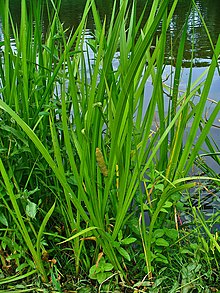Achorus calamus
The sweet calamus (Acorus calamus) is one of the two species of the genus Acorus, of the Acoraceae family. It is commonly known as "sweet mite", "aromatic mite" (calamus), "aquatic calamus" or "true calamus", and appears widely distributed in the temperate zone of the northern hemisphere, originating from Southeast Asia.
Description
Resembles sedges and has long, sharp-edged linear leaves, very pointed, about 25mm wide. The flowers, small and yellowish-green, are presented in a spiral on a bare spadix, whose spathe protrudes above. The stem extends underground in the form of rhizomes with long adventitious roots, fleshy and strongly aromatic.
It is a tall, evergreen plant with aromatic leaves and rhizomatous roots. The leaves, about a centimeter wide, reach 10 long, and are lanceolate with serrated or wavy edges. The central vein of the leaf, prominent and easily distinguishable from the barely relevant secondary veins, allows it to be easily distinguished from A. americanus. The flowers reach 4 mm, and are sterile, reproducing rhizomatically; the ovary is vestigial.
Distribution and habitat
It grows in boreal regions around the globe, although it is native to Europe. It prefers humid lands and coasts with slow or stagnant water. Its semi-woody stem was used in classical antiquity to make pens for writing.
Uses
The candied calamus root is used in Europe in confectionery, from which a stimulant and carminative drug, called calamus, is also extracted.
Uses in herbal medicine
The maceration of the sweet calamus root is not only used as a tonic in cases of general weakness of the digestive system, gas from the stomach and intestines, but it is also a powerful remedy to combat diseases of the glands as well like the drop This herbal tea greatly contributes to warming up the slow stomach and intestines and promoting the secretion of mucus. It is recommended against slow metabolism, slow digestion, as well as against chlorosis and dropsy.
Properties
It has been used for its fragrance and as a psychotropic drug. Its root was used as an anesthetic and stimulant against fatigue due to the asarone it contains; in higher doses, it produces hallucinogenic effects. Walt Whitman used this or the closely related root Acorus americanus. It figured in psychotropic potions prepared by European witches during the Middle Ages.
Active ingredients
It contains few tannins, essential oil (1.5-3.5%), rich in asarone and sesquiterpene compounds, among which acalamone stands out. In the leaves there are traces of alkaloids. Other sources: acorin, tannin, choline, essence with asarone, eugenol, pinene. Cetyl acid and palmitic acid, vitamin B1. The essence becomes viscous reaching a density of 0.36%, the yield is between 1 and 4%.
Indications
It is used as an aperitif, eupeptic, due to its bitter principles; carminative, diuretic, sedative, sudorific, hypotensive, spasmolytic, anticonvulsant, topical antirheumatic, by essential oil. Indicated for loss of appetite, hyposecretory dyspepsia, gastritis, gastroduodenal spasms, meteorism. Anxiety. States in which an increase in diuresis is required: genitourinary conditions (cystitis, ureteritis, urethritis, oliguria, urolithiasis), hyperazotemia, hyperuricemia, gout, arterial hypertension, edema, overweight accompanied by fluid retention. Chewing the root combats halitosis and firms bleeding gums.
The essential oil should not be used during pregnancy, lactation, or in children under two years of age, it is toxic to the central nervous system. It is also considered carcinogenic. Discontinuous treatments are recommended.
Taxonomy
Acorus calamus was described by Carlos Linnaeus and published in Species Plantarum 1: 324. 1753.«Acorus calamus». Tropicos.org. Missouri Botanical Garden. Retrieved October 15, 2012.
- Etymology
Acorus: Latin generic name derived from the Ancient Greek άχόρου (áchórou) of Dioscórides (with different versions of the text having different spellings). The word άχόρου itself is believed to have derived from the word κόρη (kori), which means pupil (of the eye), since the juice of the root of the plant is used as a remedy in diseases. eyepieces
calamus: Latin epithet (meaning "reed") derived from Greek ΚΆΛΑΜΟΣ (kálamos, meaning "reed"), which is cognate to the Latin term culmus (meaning "to stalk") and is derived from the Proto-Indo-European kole-mó- (se believed to mean "grass" or "reed"). The Arabic word قلم (qalam, meaning "feather") and the Sanskrit कलम (kalama, meaning "reed used as a feather& #34;, and a kind of rice) are believed to have been borrowed from the Greek.
- Varieties
- Acorus calamus var. americanus Raf. (1828).
- Acorus calamus var. angustatus Besser (1834).
- Acorus calamus var. calamus.
- Sinonimia
|
|
Contenido relacionado
White blood cell
Petiole
Popowia



